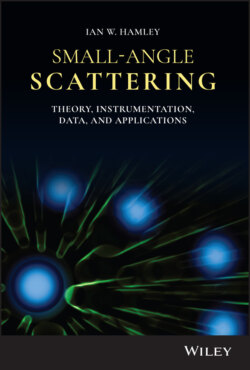Читать книгу Small-Angle Scattering - Ian W. Hamley - Страница 11
1 Basic Theory 1.1 INTRODUCTION
ОглавлениеSmall‐angle scattering (SAS) is an important technique in the characterization of the structure and order in nanostructured materials as well as biomolecules and other solutions and suspensions. This book covers both small‐angle x‐ray scattering (SAXS, the subject of Chapter 4) and small‐angle neutron scattering (SANS, discussed in Chapter 5) as well as grazing incidence small‐angle scattering (GISAS, Chapter 6). This book does not discuss small‐angle light scattering (also known as static light scattering, SLS), which is a separate topic. Although there are many similarities in the theory, light scattering is the subject of many specialist texts [1, 2], as well as chapters in texts about general SAS [3, 4]. This book also includes in Chapters 3 and 4 discussion of wide‐angle scattering, especially wide‐angle x‐ray scattering (WAXS), which can be performed along with SAXS in the characterization of certain nanomaterials including polymers and nanoparticle systems with crystal or partially crystalline ordering. Instrumentation for the different types of measurement is discussed in Chapter 3 and data analysis processes are discussed in Chapter 2.
SAS, by the nature of reciprocal space, is suited to probe structures with sizes in the approximate range 1–100 nm, which is the structural size scale corresponding to many types of soft and hard nanomaterial as well as biomolecules such as proteins in solution. Considering Bragg's law, the scattering from such large structures will be observed at small angles (less than a few degrees of scattering angle 2θ). Wide‐angle scattering covers the 0.1–1 nm range. Ultra‐small‐angle scattering (USAXS and USANS), also discussed in this book (see e.g. Chapters 3 and 5), can extend up to 1000 nm or more, which overlaps with the size scale probed by light scattering.
SANS and SAXS have complementary characteristics (Section 5.14), which are discussed in the respective chapters (Chapters 3 and 4) dedicated to these methods. These arise from the distinct natures of neutrons and x‐rays. Neutrons are nuclear particles, with a mass 1.675 × 10−27 kg. They have spin half (i.e. they are fermions) and a finite magnetic moment μn = −9.662 × 10−27 J T−1, and zero charge. In contrast, x‐rays are photons with spin 1 (they are bosons), no mass, and no magnetic moment. X‐rays are a type of electromagnetic radiation with wavelengths in the approximate range 0.01–1 nm with overlap with gamma rays at short wavelengths and the extreme ultraviolet at long wavelengths. Despite the different nature of neutrons and x‐rays, both exhibit wave‐like diffraction by matter. Using de Broglie's relationship, the associated wavelength of neutrons (this is discussed quantitatively in Section 3.6, in terms of the velocity distribution of neutrons produced by reactor and spallation sources) can be calculated.
This chapter provides a summary of the theory that underpins SAS, starting from the basic equations for the wavenumber and scattering amplitude (Section 1.2). Section 1.3 introduces the essential theory concerning the scattered intensity and its relationship to real space correlation functions, for both isotropic and anisotropic systems. Section 1.4 discusses the Guinier approximation, often used as a first analytical technique to obtain the radius of gyration from SAS data. The separation of a SAS intensity profile into intra‐molecular and inter‐molecular scattering components, respectively termed form and structure factor is discussed in Section 1.5. These terms are discussed in more detail, Section 1.6 first considering different commonly used structure factors, then Section 1.7 focusses on examples of form factors and the effects of polydispersity on form factors. Form and structure factors for polymers are the subject of Section 1.8.
